To Contact Me


Trip Reports
Year 2023/2
Year 2023/1
Year 2022/2
Year 2022/1
Year 2021
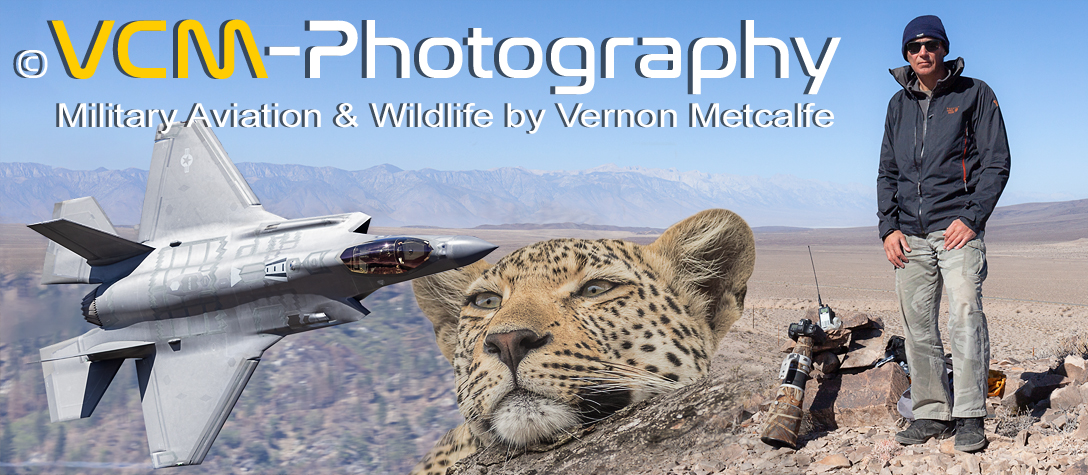
All the latest news and trip reports from my photography adventures around the U.K and abroad.
In June I had my second military low flying trip of the year with a visit to the Lake District LFA17 for three days.
Tuesday 20th - Dunmail Raise (west side). I climbed up to my chosen vantage point and was on location by 08:00.
The weather conditions looked favourable for the first hour, but soon began to deteriorate when Loughrigg Fell to the south
became obscured by an approaching rainstorm. At 10:00 I made the decision to climb down and with luck arrived at my car as the
light rain turned into a downpour. After an hour the weather began to clear, so I made the decision to locate to Smaithwaite Banks
at the north end of Thirlmere Reservoir. Whilst driving to the location a Royal Navy Merlin helicopter passed overhead routing
north to south. I stayed at Smaithwaite Banks from 13:00 to 16:15 during which time no aircraft were seen.
Wednesday 21st - I planned on visiting Silver Point, Ullswater. I was approximately at the halfway point of the
forty‑minute walk to the location when i decided to abandon the idea and relocate to Smaithwaite Banks, as Kirkstone Pass
to the south (the direction from which aircraft approach) was obscured by a thick blanket of cloud which didn't look
like clearing. At 09:40 I arrived at Smaithwaite Banks. Looking south towards Dunmail Raise and Loughrigg Fell the visibility
was a little hazy, but at least there was no sign of rain. At 12:15 I was caught off‑guard by a Eurofighter Typhoon T.3
from RAF Coningsby. I did not see the aircraft pass through the gap at Dunmail Raise due to the haze and was only aware of its approach
when I heard the howl of its engines, by which time it was too late to capture any photos. Not a good start to the day, but I did
capture photos of BAE Hawk T.2, ZK037 from RAF No. 25(F) Squadron, Valley, which appeared at 14:31. I left the hill at
16:50 with no further aircraft seen.
Thursday 22nd - Low Birk Fell, Ullswater. I arrived on the hill at 08:10, after struggling to find a suitable route
up the hill through ferns higher than myself. I was surprised how fast and high they had grown since my last visit in May. I gave myself
a thorough check for ticks which can be quite prevalent at this time of year and which thrive in such vegetation. The weather was glorious,
with clear blue skies and warm temperatures which made for a pleasant day. I was soon joined by two fellow photographers and a short
while later by two more.
The first indication of any aircraft in the area was a radio transmission from a pair of Hawk T.2's relaying their intention
to go low level. To my surprise less than thirty seconds later at 09:04, BAE Hawk T.2, ZK023 leading ZK037 appeared catching
everyone off‑guard. As a result, no keepable photos were captured. The next aircraft to appear at 09:37 were two
USAF F‑15E Strike Eagles, BuNo. 97‑0220 and BuNo. 91‑0312 from the 492nd Fighter Squadron ‘Madhatters’,
based at Lakenheath in Suffolk. They were followed at 10:20 by three more F‑15E's, BuNo. 91‑0602, BuNo. 92‑0364
(adorned with the 48th Fighter Wing heritage paint scheme) and BuNo. 01‑2002 from the 494th Fighter Squadron
‘Panthers’, also based at Lakenheath. Apparently it was one of the pilots fini flight (departure from a unit, or the last
time they fly an aircraft).
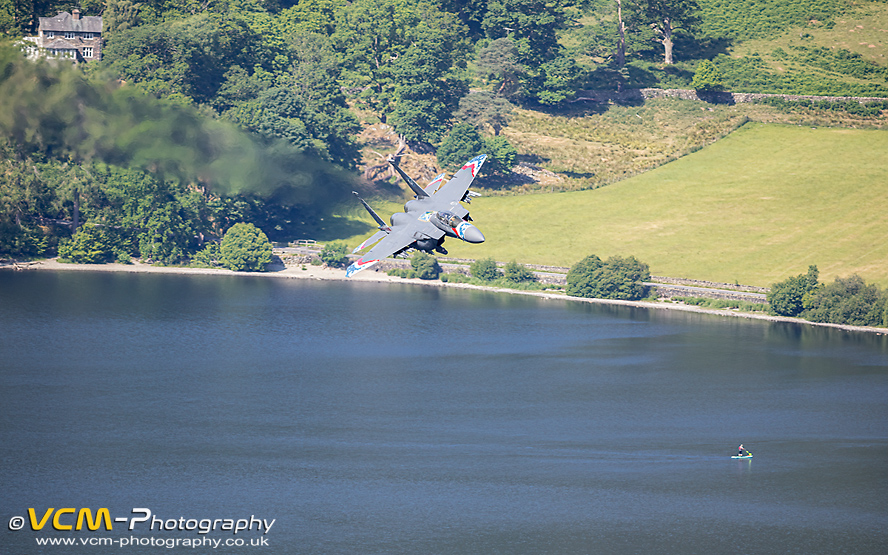 USAF F‑15E Strike Eagle (BuNo. 92‑0364) adorned with the 48th Fighter Wing heritage paint scheme.
USAF F‑15E Strike Eagle (BuNo. 92‑0364) adorned with the 48th Fighter Wing heritage paint scheme.
The afternoon turned out to be as busy as the morning, with passes by the following aircraft: BAE Systems Hawk Mk. 167, ZB131 at 15:01 from the Joint RAF & Qatar Emiri Air Force Training Squadron based at RAF Leeming, two Typhoon FGR.4's, ZJ913 and ZK331 at 15:32 and finally at 16:35 an F‑15E Strike Eagle, BuNo. 87‑0207 (in the markings of the USAF 389th Fighter Squadron ‘Thunderbolts’, Mountain Home AFB, Idaho, USA) from Lakenheath. At 16:50 two more F‑15E's appeared but passed overhead at approximately 2000ft. I left the hill at 16:55.
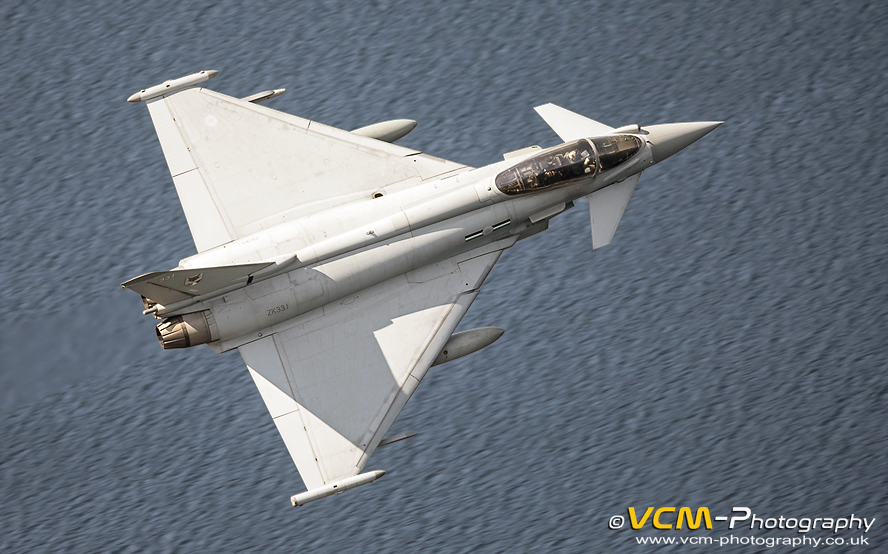 Eurofighter Typhoon FGR.4 (ZK331 ‘331’) of RAF No. 12 Sqn, Coningsby.
Eurofighter Typhoon FGR.4 (ZK331 ‘331’) of RAF No. 12 Sqn, Coningsby.
Friday 23rd - From 08:15 to 10:45 I was located at Silver Point, Ullswater. Kirkstone Pass was obscured by low cloud,
so I relocated to Smaithwaite Banks. At 12:25 I arrived on location at Smaithwaite Banks and remained there until the weather
began to deteriorate. I left the hill at 14:40 with no aircraft seen.
Photographs from my trip can soon be be viewed at:
2023 ‑ UK Military Low Flying.
Five months into the year before I've had the opportunity for a military low flying photography trip and a chance
to use my new Canon RF 600 f4 lens. My trip to California, USA, in February was to be for low flying photography, but the
unseasonable weather put the kibosh on that plan (see Trip Report February/March 2023 this page).
Tuesday 23rd - The first of two days in the Lake District. The weather forecast for the week was looking favourable with
light winds, sunny spells and more importantly, no rain. I decided to spend the two days at locations around Ullswater. Today
I tried Silver Point on the east side of Ullswater opposite the village of Glenridding. Silver Point gives you a clear view
of Kirkstone Pass, the direction from which aircraft approach. It also gives you time to react if they suddenly appear out from
Pasture Bottom which is an alternative route they can take. The only downside I find with the location is that the surrounding hills
reduce the transmissions picked‑up by my airband scanner, so listening and a visual lookout for approaching aircraft is vital.
The morning was quiet with no aircraft seen. After midday, I heard the low rumble and screech of that unmistakable noise made by a
frontline jet, as one routed down Thirlmere Reservoir to my west on the other side of the hills. I anticipated (or hoped) it
would route around and come past my location. Approximately four minutes later at 12:21 I heard a high‑pitched howl as an RAF
F‑35B Lightning appeared out from Pasture Bottom routing towards my location. It took a short while to find the aircraft
in my viewfiner (as getting used to the longer focal length of the 600mm lens) and when I did, it went blurred and I lost it. The
same happened a second time. I did not observe the aircraft serial and I only captured a couple of blurred images as the F‑35
routed past. Disappointed, I put the experience down to being tired after a six‑hour drive.
At 14:01, I spotted an Embraer Phenom T.1, ZM333 of RAF No. 3 FTS/46 Sqn, Cranwell, passing through the gap at
Kirkstone Pass routing down towards my location. When I checked the back of my camera after the Phenom had routed past, all the images
I had captured appeared to be soft or out‑of‑focus. Puzzled, I initially thought the camera viewfinder dipoter was set incorrectly.
I was checking my lens and camera menu settings, when at 14:12 I noticed an Airbus A400M Atlas C.1, ZM413 routing down from Kirkstone Pass.
Again, all the images captured were soft or out‑of‑focus. Now feeling a tad frustrated and naffed‑off I went through
my camera settings again. Eureka !! ‑ found the problem. To cut a long story short, I had previously been using
my camera for taking landscapes and when changing the settings back for my aircraft photography I had stupidly forgot to change the
One‑Shot setting to Al‑Servo. This was the reason the camera would initially focus on the aircraft, but as the aircraft moved
focus would be lost. A schoolboy error and a first for myself, but one which I will not make again. Lady Luck did shine a little. When I
downloaded the photos, I found I had managed to get one sharp image of both the Phenom and the Atlas.
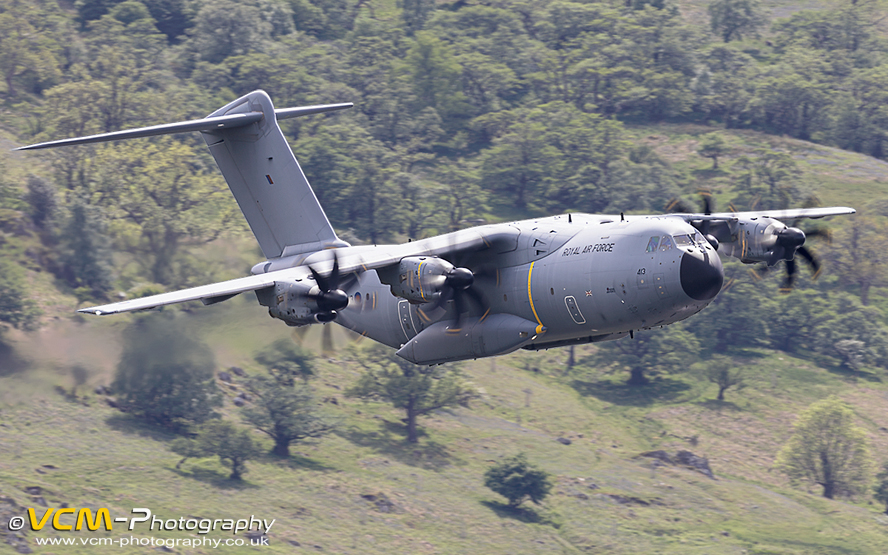 Airbus A400M Atlas C.1 (ZM413 ‘413’) of RAF No. 24/70/206 Sqn's, Brize Norton.
Airbus A400M Atlas C.1 (ZM413 ‘413’) of RAF No. 24/70/206 Sqn's, Brize Norton.
Wednesday 24th - Low Birk Fell, Ullswater. Another warm and sunny day. After arriving on the hill at 08:00 I was soon
joined by two fellow photographers. The first and only passes of the day at 09:13 were two BAE Hawk T.2's, ZK023 leading ZK020.
I only captured keepable photos of ZK023, as ZK020 was too close behind to have time to lock onto. The remainder of the day was quiet, with
little activity on the airband scanner, but the banter with my fellow photographers made for a pleasant day. There was hope of an
A400M Atlas routing through which had dropped down to low‑level at the southern end of Windermere (at approximately 16:20),
but nothing materialised. I left the hill at 16:30, as I had a long drive home and was working the following day.
Photographs from my trip can be viewed at:
2023 ‑ UK Military Low Flying.
On Monday 17th April at 19:35 my wife and I departed London Heathrow on a British Airways Boeing 787 for an
overnight flight to New Delhi, India, for a photography safari to Ranthambhore National Park, which is in the
Sawai Madhopur district of southeast Rajasthan.
Tuesday 18th ‑ We landed at New Delhi Indira Gandhi International Airport at 08:30 after an 8.5‑hour flight.
After clearing customs and converting our money to rupees, we travelled to Claridges Hotel in the city centre, where we had
breakfast and used the restroom facilities to freshen‑up. From the hotel it was a short drive to the Hazrat Nizamuddin
rail station to catch our 12:45 train departure to Sawai Madhopur.
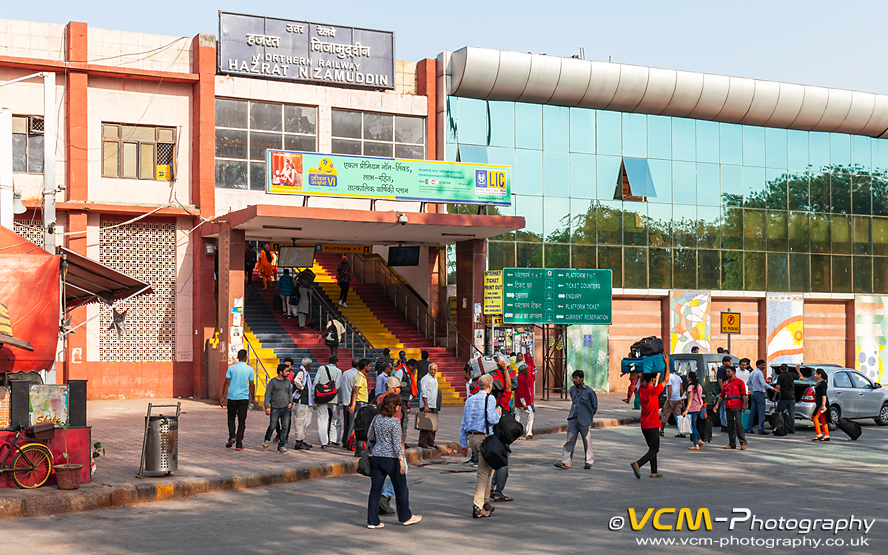 Hazrat Nizamuddin railway station, New Delhi.
Hazrat Nizamuddin railway station, New Delhi.
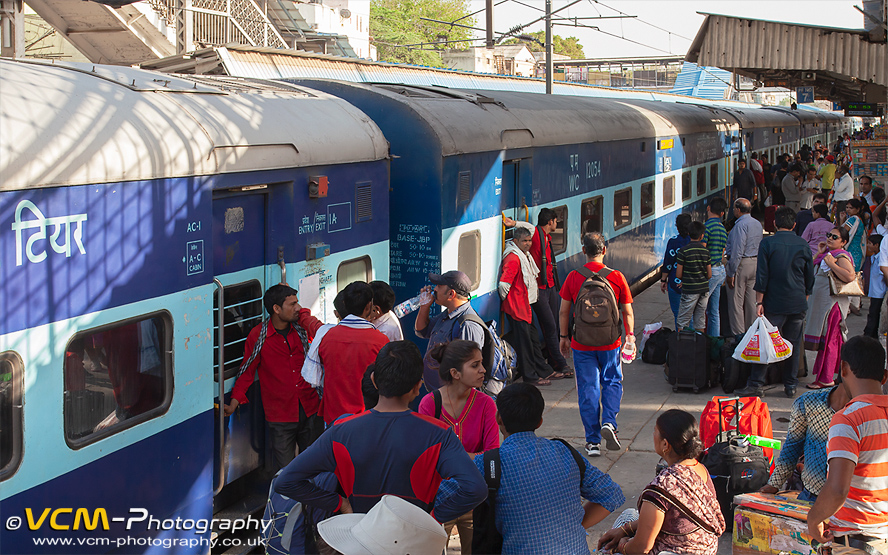 Express train to Sawai Madhopur awaits.
Express train to Sawai Madhopur awaits.
After nearly a five‑hour journey our Kota‑Hazrat Nizamuddin Jan Shatabdi Express arrived at Sawai Madhopur.
From the station it was only a short taxi ride to our hotel, the Ranthambhore Kothi, which is located close to the park
entrance.
We previously visited the hotel in early 2020 when on safari to Ranthambhore. The main reason we chose the hotel over others,
apart from the clean, comfortable rooms, very friendly and helpful staff, was the food. The hotel caters for local visitors,
but also European visitors like myself, whose diets don't always agree with the local delicacies. On both visits I never
experienced an upset stomach.

Ranthambhore National Park is one of the biggest and renowned national parks in Northern India. The once former hunting grounds of the Maharajas of Jaipur, today the park is a major wildlife tourist attraction that has drawn the attention of many wildlife lovers and photographers. Over the next eight days and fifteen jungle safaris, we hired our own Suzuki Gypsy vehicle (the only permitted ones allowed in the park) and naturalist/tracker. The benefit of conducting a safari on your own is that we are not constrained by the wishes of others ‑ for example: wanting to spend more time at a particular wildlife sighting (i.e. be it a tiger or rufous treepie). The Suzuki Gypsy vehicles which are “compact” and have good all‑around visibility for photography, sometimes lack leg room for taller people, so having our own jeep gave me plenty of room to sit comfortably and store my camera equipment.
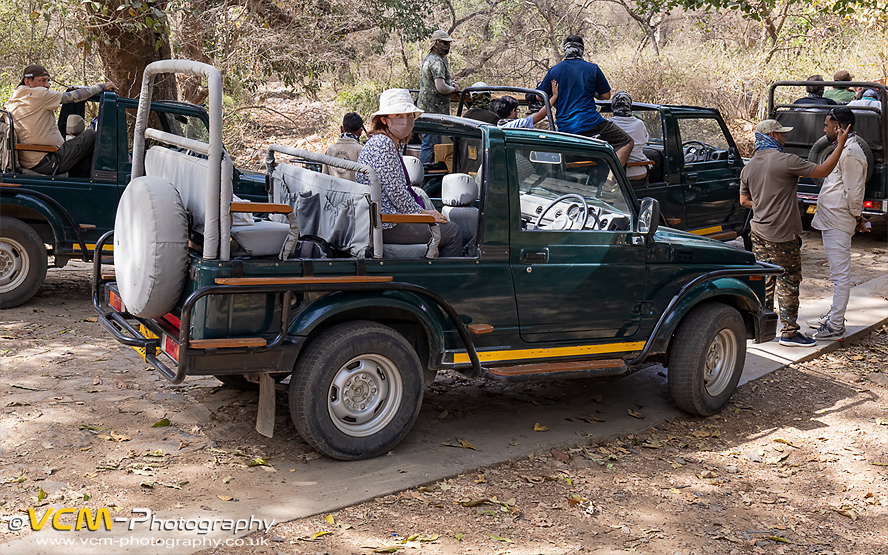 Suzuki Gypsy vehicles waiting to enter the park.
Suzuki Gypsy vehicles waiting to enter the park.
Ranthambhore National Park, like other parks in India is open between October to June. The parks close during the monsoon
season of July to September, as dry riverbeds become torrents of flowing water, with jungle tracks becoming flooded and impassable.
The monsoon break also provides an opportunity for the forest to rejuvenate itself. (Note: Ranthambhore zones 1‑5 close,
but zones 6‑10 remain open during the monsoon season).
We decided to visit in April as its hot (but not as oppressive as May/June) and wildlife tends to congregate near the waterholes.
The vegetation is not lush and green as in the winter months, so spotting wildlife is easier.
The itinerary for the next eight days was as follows:
Up early (05:15) for our morning game drive, as the park opens at 06:00. A cup of coffee and some biscuits in the
hotel lounge helped wipe away the tiredness as we waited for our naturalist/tracker and his jeep driver to arrive. From the hotel it was only
a ten‑minute drive to the park entrance, where we had to show our passports. The passport details must match those of the original booking,
otherwise access will be denied. All jeeps must exit the zone by 09:30, or the naturalist and driver could be fined or given a limited ban.
We then return to the hotel for a hearty breakfast and have free time till lunch, which was served at 13:30. After lunch we had more free time
till the afternoon safari. The park opened for the afternoon safari at 15:00 and closed at 18:30. Returning to the hotel, we had
time for a shower and change of clothes before the evening meal. After the evening meal we retired for the evening after a long exhausting
but enjoyable day.
Wednesday 19th.
Morning safari, zone 4 ‑ Entry and exit gate is the Singh Dwar. A quiet safari with no tigers seen. Two jackals crossed
the road ahead, but disappeared before I could take any photos.
Afternoon safari, zone 2 ‑ Entry and exit gate is the Singh Dwar. My first photo opportunity of a sloth bear. Normally they
are very shy and elusive, with the bear disappearing as soon as it appears, but this was a large confident male walking along a dry riverbed,
which allowed ample time to take photos. First tiger sighting was of tigress T‑105 ‘Noorie’. The tigress approached from
zone 3 following the river. She passed our jeep and lay down on the road with her back towards us, but she did turn occasionally to present
some nice facial photos. Some spotted deer (chital) attracted her attention and she started stalking them, but soon lost interest
and fell asleep on the riverbank.
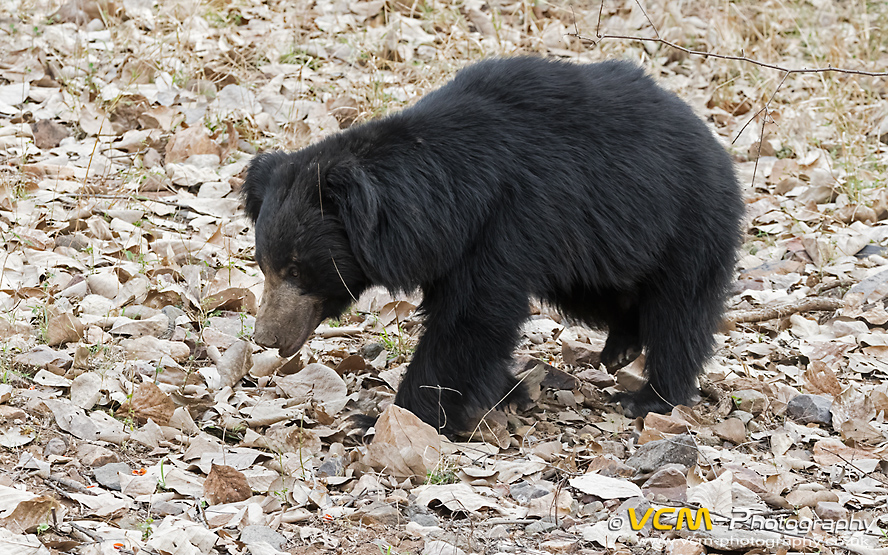 Male sloth bear walking along a dry riverbed in zone 2.
Male sloth bear walking along a dry riverbed in zone 2.
Thursday 20th.
Morning safari, zone 3 ‑ Entry and exit is through the Jogi Mahal Gate. A favourite zone of many tourists due to the good tiger
sightings and stunning scenery. Entering the zone, you pass the Padam Lake with the historic Ranthambhore Fort overlooking
the area creating a scenic backdrop. Further on, standing on the shore of the Raj Bagh Talao Lake is the abandoned ruins of the Raj Bagh,
once a hunting lodge of the Maharaja of Jaipur. The derelict building is a favourite place for tigers and leopards to avoid the summer heat
and relax in the shade.
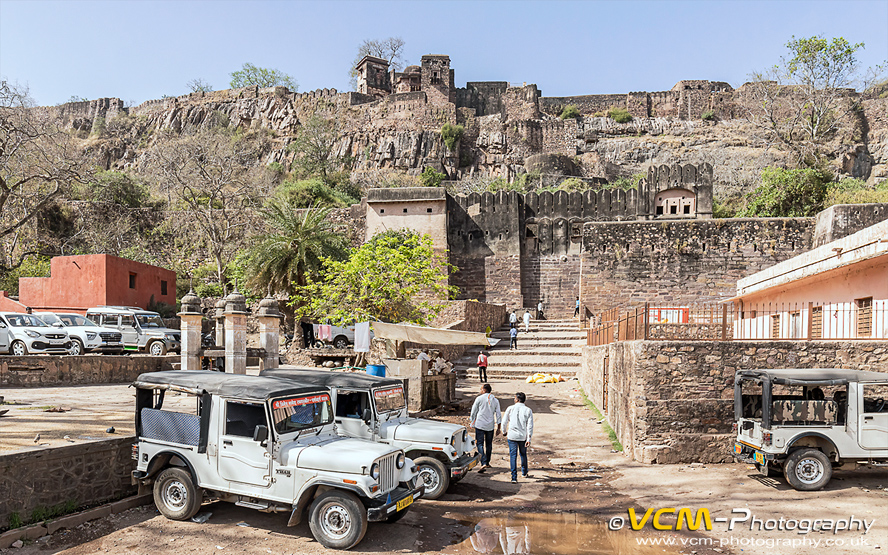 Ranthambhore Fort viewed from the Jogi Mahal Gate.
Ranthambhore Fort viewed from the Jogi Mahal Gate.
This morning we had a sighting of tigress T‑124 ‘Riddhi’ who suddenly appeared from the jungle and crossed the road
ahead of us. Our naturalist anticipated where she would re‑appear, as tigers patrol their territory using the same jungle tracks.
We waited where a known trail crossed the road, but the tiger did not appear. Eventually we moved‑on and approached a man‑made
waterhole where we found ‘Riddhi’ happily relaxing, cooling‑off in the water. I first saw ‘Riddhi’ along with
her sister ‘Siddhi’ during my first visit to Ranthambhore in March 2019 when they were approximately three months old.
They were with their mother T‑84 ‘Arrowhead’ and were at an age where the forest department had not yet given them names.
Later in the safari we had a sighting of the dominant male, T‑120 ‘Challenger’. He went into the ruins of the
Raj Bagh hunting lodge, but soon re‑appeared and cooled‑off in the lake. Eventually he crossed the relatively shallow lake and
walked past our jeep. An excellent end to the morning safari.
Afternoon safari, zone 5 ‑ Entry and exit gate is the Singh Dwar. Sloth bears were becoming like waiting for a bus.
Never see any and then you end up having many sightings. Again, it was a large male. This bear was climbing a tree trying to get a beehive.
All the jeeps in the vicinity beat a hasty retreat to avoid the swarm of bees that suddenly engulfed the bear. The bear eventually climbed
down the tree and walked along the riverbank, where she disturbed an adult tigress, T-41 ‘Laila’ lying in the undergrowth.
(fortunately, there was no conflict between the bear and the tiger). For the next twenty minutes ‘Laila‘ treated us to
some wonderful photo opportunities.
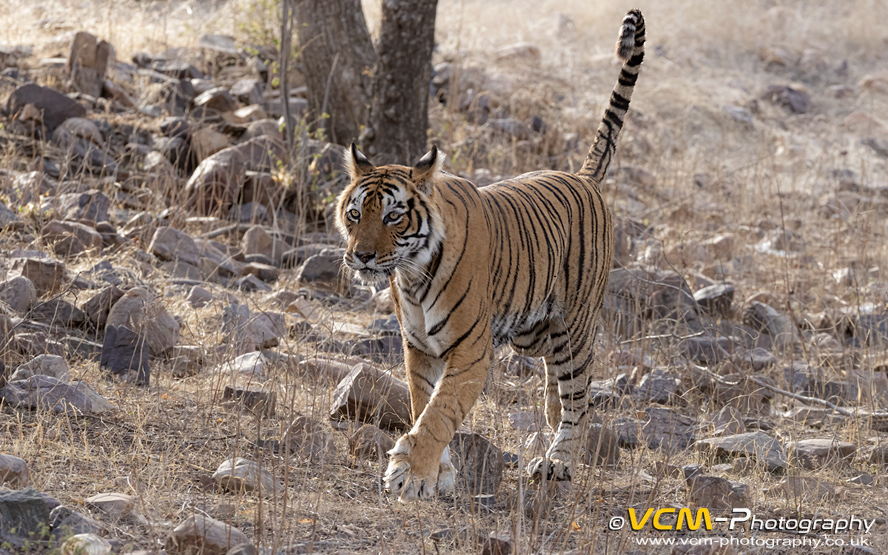 Tigress, T-41, Laila. Zone 5.
Tigress, T-41, Laila. Zone 5.
Friday 21st.
Morning safari, zone 4 ‑ We checked all the waterholes. We did see fresh pugmarks, but there were no alarm calls. The deer which
graze on the hills during the evening for safety had moved back down to the lower areas to drink and graze and were looking relaxed.
No tigers were seen.
Afternoon safari, zone 1 ‑ Entry and exit gate is the Singh Dwar. Very quiet with no alarm calls.
Saturday 22nd.
Morning safari, zone 5 ‑ Approximately five minutes after entering the park we heard alarm calls. Nothing was seen and we assumed it
was a leopard as they are known to favour the area. No tigers were seen.
Afternoon safari, zone 5 ‑ We were late entering the park, as Vijay Kumawat our naturalist had fallen off his scooter and injured
himself, so we had to wait for his replacement. The replacement naturalist had been informed from a morning safari, that a tiger had been
sighted in the vicinity of where zone 5 borders zone 4. We waited in the area, along with several other jeeps, but the tiger
did not appear.
Sunday 23rd.
Morning safari, zone 1 ‑ Where zone 1 borders with zone 6 we heard sambar deer and monkey alarm calls. A sambar deer warning call
is regarded as a 99% guarantee of a tiger. The tiger was assumed to be hidden from view in a dry riverbed. We waited for over an hour
but the tiger did not appear.
Afternoon safari, zone 3 ‑ A wild boar killed by the tigress T‑124 ‘Riddhi’ was known to be lying under a tree in
a dry river gorge. A lot of jeeps had congregated around the area hoping she would return to feed on the boar, but she did not appear.
We searched the area around the Raj Bagh Talao Lake and were informed that ‘Riddhi’ had been seen earlier entering the long grass
that borders the lake. Nearing the exit time and with no sign of the tiger we decided to leave the area. Driving around the lake towards the
exit on our own, we suddenly came across ‘Riddhi’ lying by the side of the track ‑ unbelievable. It was nice to watch
and photograph the tiger lying peacefully in the fading light of the day, without the chaos and pandemonium that can normally happen when several
jeeps witness a sighting. By the time other jeeps arrived, ‘Riddhi’ had left. I considered the sighting one of those moments that will
stick in my memory for a lifetime.
Monday 24th.
Morning safari, zone 4 ‑ Apart from an alarm call from a spotted deer, it was a quiet safari with no tiger seen.
Afternoon safari, zone 5 ‑ Another quiet safari with no tiger seen.
Tuesday 25th.
Morning safari, zone 3 ‑ Tigress T‑124 ‘Riddhi‘ was sighted sleeping in the long grass bordering the Raj Bagh Talao Lake.
We left the sighting to search for the male tiger T‑120 ‘Challenger’. We did not find him, but did find three young
dusky eagle‑owls perched in a tree. After photographing the owls, we went back to where ‘Riddhi’ was sighted. Some spotted deer
had entered the area and where grazing on the lush grass by the lake and ‘Riddhi’ was awake and aware of them. The deer were very
cautious and kept away from the long grass where ‘Riddhi’ was hiding. Eventually they sensed her and scattered.
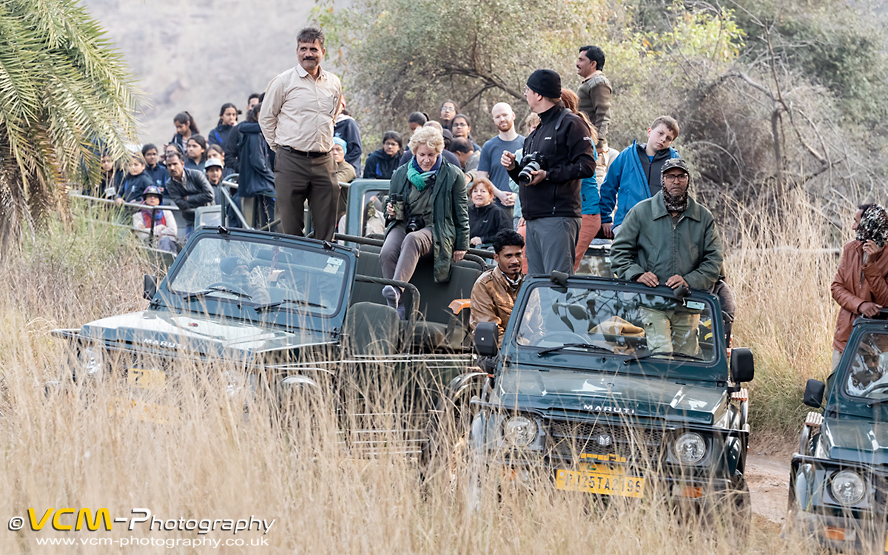 Jeeps full of expectant wildlife observers waiting for tigress T‑124 ‘Riddhi’ to appear.
Jeeps full of expectant wildlife observers waiting for tigress T‑124 ‘Riddhi’ to appear.
Afternoon safari, zone 2 ‑ We checked all the waterholes but heard no alarm calls or saw any signs of a tiger. We were having a comfort break at a forest checkpoint, when a forest officias jeep pulled‑up. The driver informed us that he had sighted a tiger by the river a few miles back. We immediately rushed to the area along the narrow bumpy track (my backside was off the seat, more than on it).When we saw spotted deer grazing on the riverbank, we realised we must have passed the location, so we doubled back. Eventually we sighted the tigress T‑84 ‘Arrowhead’ lying on the opposite riverbank. ‘Arrowhead’, the mother of ‘Riddhi’ and ‘Siddhi’ had been ousted from her territory in zone 3 by her daughter ‘Riddhi’, so she now resided in zone 2. She remained relaxed as more jeeps arrived at the sighting. Eventually she rolled over and fell asleep and it was time for us to leave.
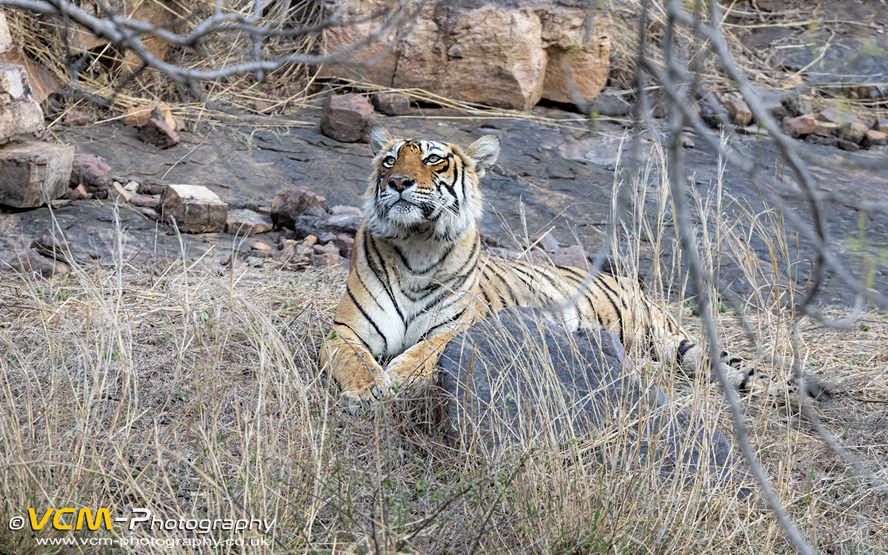 Tigress T‑84, Arrowhead, lying peacefully on the riverbank in zone 2.
Tigress T‑84, Arrowhead, lying peacefully on the riverbank in zone 2.
Wednesday 26th.
Morning safari, zone 4 ‑ Final safari. Lots of pugmarks were seen, but the jungle was quiet. No alarm calls were heard and we exited
the zone with no tigers seen. After lunch it was time to bid our farewells to our naturalist and hotel staff and make the 160km (approx.
3 hours) journey by private taxi to Jaipur to catch an internal flight back to New Delhi, from where we boarded our B.A. flight back to
the U.K.
Photographs from my trip can be viewed at:
2023 ‑ Ranthambhore, India..
As the saying goes: “The best-laid plans go astray”. This is what happened on my first planned photography
trip of 2023. The original plan was to visit various locations in the Sidewinder military low flying area of California, USA. Everything
was planned, with the car hire and hotels/lodges all booked for the 9‑day trip. The only thing out of my control was the weather.
The week preceding my trip, the weather forecast for the areas I planned to visit was looking dire, with winter storms and heavy snowfall
forecast. As my departure date approached the weather forecast did not improve, so I made the decision (a wise one in retrospect) to
cancel my accommodation and plan an alternative itinerary. With the plans of any military low flying photography scuttled, I decided upon
spending my time visiting some aviation museums and general sightseeing.
Friday 24th February - At approximately 19:15 (local time) my British Airways Airbus A380 flight from London Heathrow
approached Los Angeles LAX in some of the worst weather I have seen in the area. After safely landing, clearing customs and immigration,
I picked up my hire car and stayed overnight at a local airport hotel. Through the night, LAX was closed for 3‑4 hours due to high winds
and torrential rainfall.
Saturday 25th February - Watching the early morning weather update on the TV, I was thankful I had cancelled my original plans to travel
north, as the Highway 14 between Los Angeles and Palmdale and the Interstate 15 over the San Bernardino Mountains were closed due to heavy snow
and blizzard conditions. In Los Angeles it was raining heavy and the forecast for the area for the remainder of the day was for heavy
intermittent rain showers. I had planned to visit the Yanks Air Museum in Chino, then stay overnight at Lake Elsinore, before heading south on
the Sunday to San Diego. Due to the weather conditions, it was not ideal for viewing and photographing the aircraft located outside at the museum,
so I decided to drive straight to San Diego and try and visit the museum on my way back later in the week. Driving from Los Angeles to San Diego
along the Highway 91 and Interstate 15 was probably the worst driving conditions I have ever experienced. Heavy downpours of rain with reduced
visibility, combined with cars lane‑hopping, speeding, driving too close behind and not having their headlights on in such adverse conditions
made it quite a nerve‑racking experience.
Sunday 26th February - Visited the San Diego Air & Space Museum
at Balboa Park. I had visited the museum in November 2019, but photography was hindered due to the museum preparing for a function in the
Edwin D. McKellar Pavilion of Flight, and as I was unable to capture all the exhibits another visit was always considered.
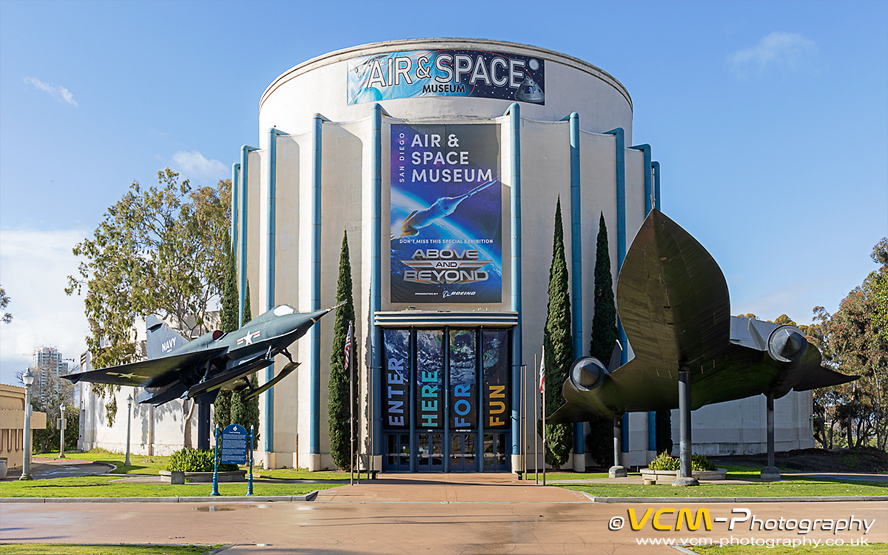 Entrance to the San Diego Air & Space Museum, housed in the old Ford Building, Balboa Park, San Diego. In front of the museum are
exhibited (L‑R) a Convair YF2Y‑1 Sea Dart and Lockheed A‑12.
Entrance to the San Diego Air & Space Museum, housed in the old Ford Building, Balboa Park, San Diego. In front of the museum are
exhibited (L‑R) a Convair YF2Y‑1 Sea Dart and Lockheed A‑12.
Monday 27th February - Today I was driving the 405 miles to Tuscon. I had a 5:30am start, not only to avoid the early morning
commuter traffic, but to get to El Centro, California, a two‑hour drive away, in the hope of catching the first practise flight of the day
for the U.S. Navy aerobatic demonstration team the Blue Angels. The Blue Angels practise at Naval Air Facility El Centro from January till March
and their first training flight of the day is normally scheduled for 8am. I arrived at the perimeter fence at the far end of runway 12, the noted
departure runway for the team at 7:30am. There was already a line of vehicles parked‑up, with aviation enthusiasts and their step ladders
waiting in anticipation for the event. A small pair of step ladders (2‑3 steps) is recommended to see over the airfield perimeter fence,
but as I did't have any I opened the back door of the car and by standing on the door sill and propping myself up against the door post I managed
to get an unobstructed view of runway 12/30. Any aircraft taxiing at the near end of the runway though (runway 30 departure end) would
be obstructed by the fence poles and netting.
At 8am on a pleasant warm sunny morning, the Blue Angels #1 to #4 aircraft lined‑up on runway 12, four‑abreast and started their
take‑off. The four F/A‑18C's in full afterburner passed overhead my location at approximately 125‑150ft in a deafening roar.
The shock wave rocked the car and set‑off adjacent vehicle car‑alarms. For the next five minutes they passed overhead in different
formations before heading south into the remote desert area to practise their routine. After approximately 50 minutes the four aircraft returned
and landed on runway 12. After leaving the runway, the Blue Angels lead and opposing solo #5 and #6 aircraft departed from runway 30 for
their session, returning 30 minutes later, landing on runway 12.
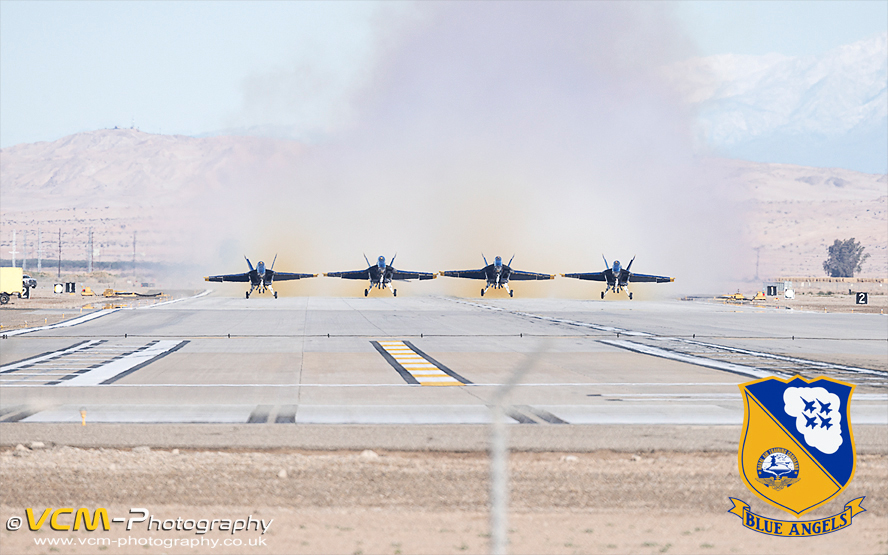 Blue Angels F/A‑18C Super Hornets start their take‑off at El Centro, California.
Blue Angels F/A‑18C Super Hornets start their take‑off at El Centro, California.
A surprise bonus was the USAF Thunderbirds aerobatic demonstration team were visiting El Centro and they too did a training session late morning,
departing from runway 12, but landing back on runway 26. Throughout my short visit, F/A‑18 Hornets were also arriving and departing from
runway 26. No photos were captured of aircraft using this runway as they were too distant and as I was only visiting for a limited time I did not
move to the required viewing location.
Well‑pleased with my visit, I spent the remainder of the day driving to Tucson, arriving in the Arizona city early evening.
Tuesday 28th February - The first of two days spent visiting the Pima Air & Space Museum, Tucson, Arizona. Pima is one of the world's
largest non‑government funded aerospace museums. The museum features a display of nearly 300 aircraft spread out over 80 acres. The aircraft
are displayed outside, or in one of the museum's four hangars. As the weather forecast for the following day was looking unfavourable, I decided
to spend the day viewing and photographing the exhibits located outside. One notable exhibit and recent addition to the museum's inventory
is the NASA SOFIA Boeing 747 (registration N747NA). The aircraft is a heavily modified version of Boeing 747SP, carrying a reflecting
telescope observatory, which was designed for infrared astronomy observations. Flying in the stratosphere at 38,000 to 45,000ft puts the airborne
telescope above 99 percent of the Earth's infrared‑blocking atmosphere, allowing astronomers to study the solar system and beyond in ways
which was not possible with ground‑based telescopes.
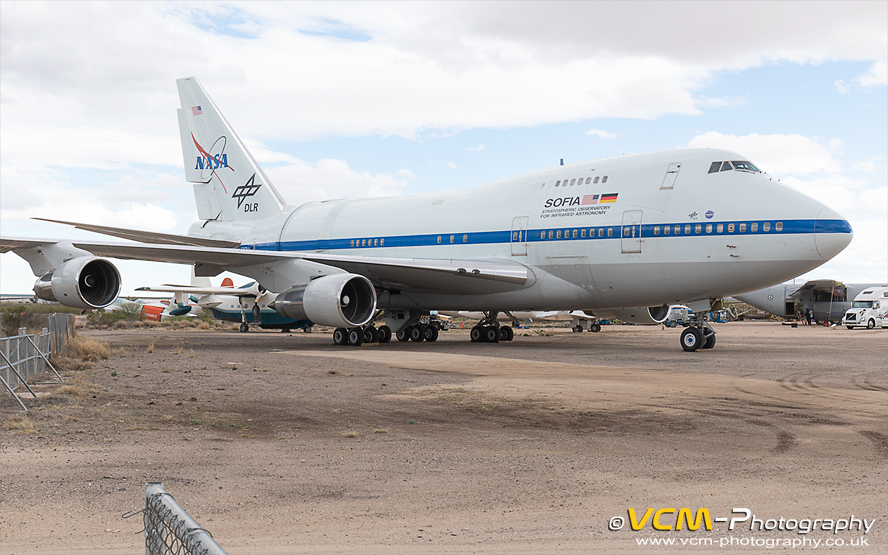 NASA SOFIA Boeing 747SP (Registration N747NA). The aircraft was not officially on display during my visit.
NASA SOFIA Boeing 747SP (Registration N747NA). The aircraft was not officially on display during my visit.
Wednesday 1st March - Another day spent at Pima. I finished off viewing/photographing the remaining aircraft located outside as the
weather was favourable, but went indoors mid‑morning to view the exhibits located in the hangars, as the winds had picked‑up as
forecast.
The museum is located next to the Davis‑Monthan Air Force Base and throughout both days I observed many A‑10 Thunderbolt's
departing/arriving or doing circuits of the airfield. I also observed a mixed flight of two T‑38 Talon's with a P‑51D Mustang
and later F‑22 Raptors practising for the March 25th/26th ‘Thunder & Lightning Over Arizona Air Show’.
Thursday 2nd March - I awoke early morning to a blanket of snow. Snow in Tucson ‑ unbelievable.
Today I was driving to Palm Springs. I delayed my departure till 10am, to give the light covering of snow time to clear. The 380‑mile drive
to Palm Springs went without incident, arriving early evening.
Friday 3rd March - Visited the Yanks Air Museum, Chino. The museum houses one of the largest and most historically significant collections
of American aircraft, covering the period from 1903 to 1984. The majority of the aircraft are exhibited in the museum's two hangars, but there
is also access to the main restoration hangar and adjoining boneyard, where aircraft are stored or in various stages of restoration.
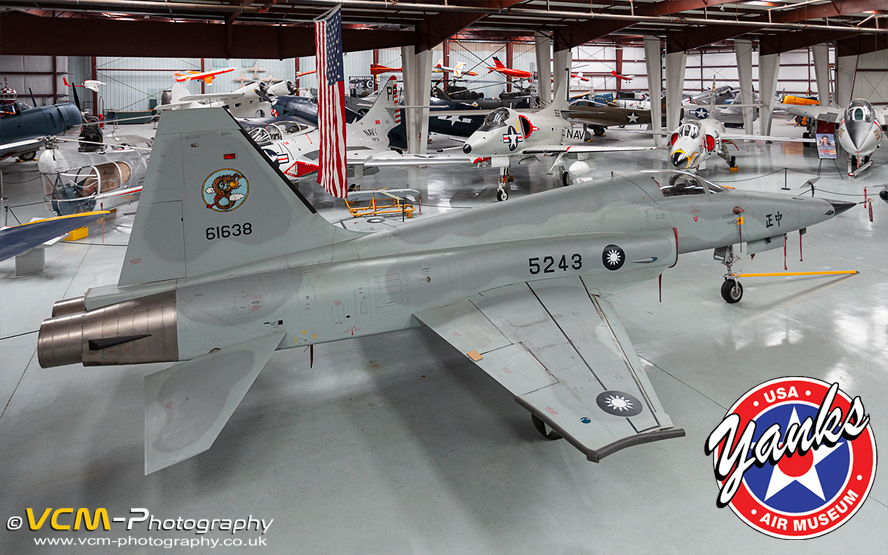 Northrop F‑5E Tiger II (BuNo. 76‑1638) in the Starfighter Hangar, Yanks Air Museum.
Northrop F‑5E Tiger II (BuNo. 76‑1638) in the Starfighter Hangar, Yanks Air Museum.
The museum attempts to restore all aircraft to an airworthy condition, though some will never be flown due to their rarity.
After I finished visiting the museum I made the 40‑mile drive to Elsinore to stay overnight.
Saturday 4th March - In the morning I visited Skydive Elsinore. I used to visit the drop zone back in the late 1990's and
early 2000's when I was a regular jumper. It was nice to relax for a couple of hours with a coffee and watch the many skydivers pack
their parachutes and dirt dive (practise their planned routine/formations) for their next jump. From the spectator area located
adjacent to the parachute landing zone I could watch as the skydivers board either the Twin Otter or Cessna Caravan jump aircraft and then land
back on the drop zone (DZ).
Photographs captured from my skydiving days can be seen at:
Skydive ‑ Digital Photos.
Skydive ‑ Scanned 35mm Film.
After leaving Elsinore I made the drive back into Los Angeles, where I visited the
Proud Bird Food Bazaar & Events Center, located near LAX.
The aviation‑themed restaurant located on Aviation Blvd, has a collection of original, replica and mock‑up aircraft exhibited in front
of the restaurant. From the grounds, one can observe aircraft departing and landing on LAX's runway 25L. After a late lunch, it was time to return
the hire car and make my way to LAX for my late evening flight back to the U.K.


Year 2023/2
Year 2023/1
Year 2022/2
Year 2022/1
Year 2021